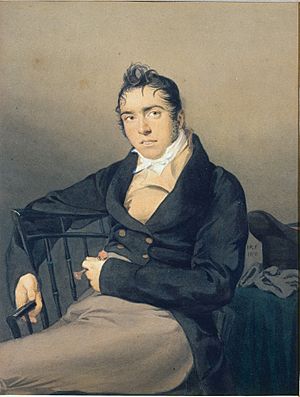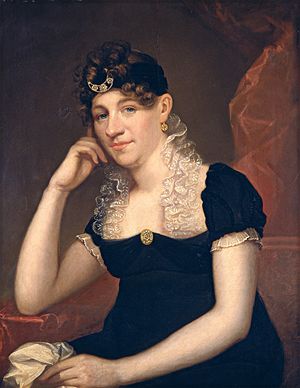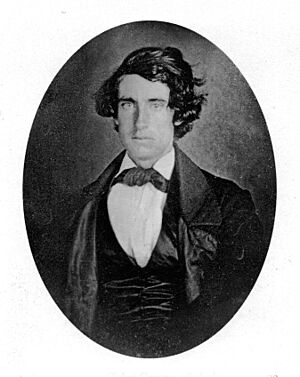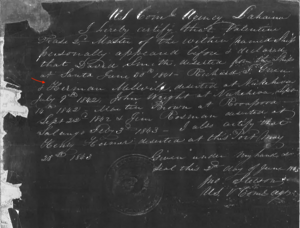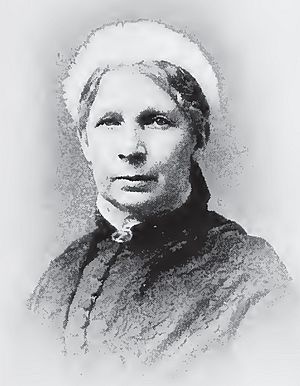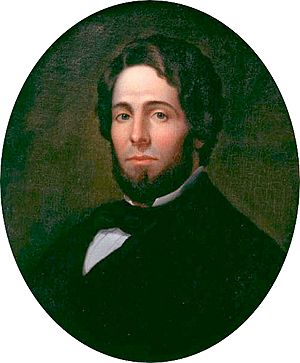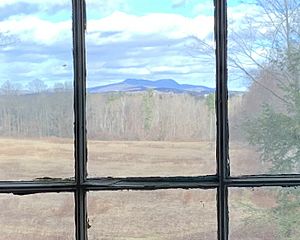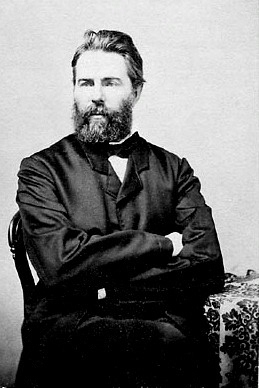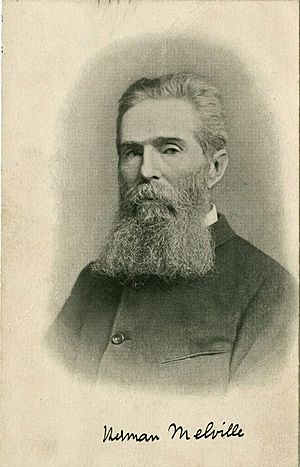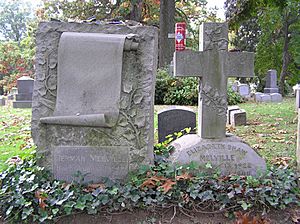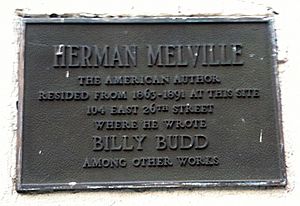Herman Melville facts for kids
Quick facts for kids
Herman Melville
|
|
|---|---|
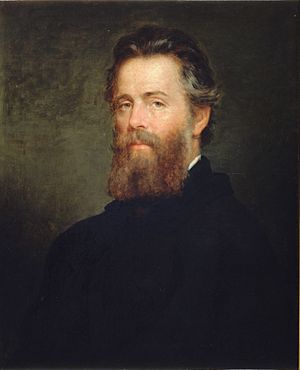
Portrait of Melville by Joseph Oriel Eaton, oils on canvas, 1870
|
|
| Born | Herman Melvill August 1, 1819 New York City, U.S. |
| Died | September 28, 1891 (aged 72) New York City, U.S. |
| Resting place | Woodlawn Cemetery, New York City |
| Occupation |
|
| Education | The Albany Academy |
| Genres | Travelogue, captivity narrative, nautical fiction, gothic romanticism, allegory, tall tale |
| Literary movement | Romanticism |
| Spouse |
Elizabeth Knapp Shaw (1822–1906)
(m. 1847) |
| Children | 4 |
| Signature | |
Herman Melville (born Melvill; August 1, 1819 – September 28, 1891) was an American writer. He wrote novels, short stories, and poems. He lived during the American Renaissance period.
Some of his most famous books include Moby-Dick (1851). He also wrote Typee (1846), which was about his adventures in Polynesia. Another well-known work is Billy Budd, Sailor, which was published after he died. When he died, he was not very famous. But in 1919, people started to rediscover his work. Now, Moby-Dick is seen as one of the greatest American novels.
Melville was born in New York City. His family was wealthy, but his father died in 1832. This left the family in a very difficult financial situation. In 1839, he became a sailor on a merchant ship. Then he worked on a whaling ship called Acushnet. He left the ship in the Marquesas Islands. His first book, Typee, and its follow-up, Omoo (1847), were adventure stories. They were based on his time with the people of these islands. These books were successful. This success allowed him to marry Elizabeth Shaw.
Melville's writing became more ambitious with Moby-Dick (1851). This book took him almost a year and a half to write. However, it did not become popular. Critics did not like his next novel, Pierre: or, The Ambiguities (1852). From 1853 to 1856, Melville wrote short stories for magazines. These included "Benito Cereno" and "Bartleby, the Scrivener". In 1857, he traveled to England and the Near East. He then published his last prose book, The Confidence-Man (1857). In 1863, he moved to New York. He later became a United States customs inspector.
After this, Melville focused on poetry. Battle-Pieces and Aspects of the War (1866) was a collection of poems. It explored the moral questions of the American Civil War. In 1867, his oldest son, Malcolm, died at home. His long poem, Clarel: A Poem and Pilgrimage in the Holy Land, was published in 1876. In 1886, his other son, Stanwix, died. Melville then retired. In his last years, he published two poetry books privately. He left one book unpublished. The short novel Billy Budd was not finished when he died. It was published in 1924. Melville died in 1891 from a heart condition.
Contents
- Herman Melville's Life Story
- His Family and Early Years
- Schooling and His Father's Death
- Working as a Clerk
- Changing Jobs and Studies
- Becoming a School Teacher
- His Years at Sea (1839–1844)
- Becoming a Successful Writer (1845–1850)
- Hawthorne and Moby-Dick (1850–1851)
- Struggles as a Writer (1852–1857)
- Life as a Poet (1857–1876)
- His Final Years (1877–1891)
- How Herman Melville Wrote
- Main Ideas in His Books
- His Legacy and Honors
- Images for kids
- See also
Herman Melville's Life Story
His Family and Early Years
Herman Melville was born in New York City on August 1, 1819. His parents were Allan Melvill (1782–1832) and Maria (Gansevoort) Melvill (1791–1872). Herman was the third of eight children. His family had Scottish and Dutch roots. His brothers and sisters were important in his life and career.
Both of Melville's grandfathers were heroes of the Revolutionary War. This made Melville proud of his "double revolutionary descent." His grandfather, Major Thomas Melvill, took part in the Boston Tea Party. His other grandfather, General Peter Gansevoort, was famous for defending Fort Stanwix in New York in 1777.
Herman Melville had a rich and comfortable childhood in the 1820s. His family lived in a large house with several servants. However, his father, Allan Melvill, spent more money than he had. He borrowed a lot from his own father and his wife's mother. In 1830, the Gansevoort family stopped giving them money. Allan was deeply in debt.
Schooling and His Father's Death
Herman Melville started school when he was five. His schooling stopped when he was 12, after his father died. In 1824, Herman and his older brother Gansevoort went to the New York Male High School. In 1826, Herman got scarlet fever. His father said Herman was "very backwards in speech" at first. But he improved and became the "best Speaker" in his class.
In 1829, Herman moved to Columbia Grammar and Preparatory School. His father wrote that Herman was "making more progress." He said Herman was a "most amiable and innocent child."
In 1830, Herman's father moved the family to Albany, New York. He tried to start a fur business. Herman went to the Albany Academy from October 1830 to October 1831. He studied many subjects, including history and math. In August 1831, Herman was honored as one of the city's "finest scholars." He received a book of poems and prose.
However, Melville had to leave the Academy in October 1831. The small tuition fee was too much for his family. In December, his father became very ill after a difficult trip. He died on January 28, 1832. Herman was likely there to witness these sad events.
Working as a Clerk
His father's death changed the family's life greatly. His mother, Maria, found comfort in her faith. She joined the First Reformed Dutch Church. Herman was deeply influenced by his mother's strong religious beliefs.
Two months after his father died, Herman's brother Gansevoort started a cap and fur business. Herman got a job as a clerk at the New York State Bank. He earned $150 a year. In 1834, when he was 14, the bank trusted him enough to send him on an errand. He was also very interested in drawing. Art became a lifelong hobby for him.
Around May 1834, the Melvilles moved to a new house in Albany. That same month, a fire destroyed Gansevoort's factory. He could no longer afford his workers. So, he took Herman out of the bank to help him in the cap and fur store.
Changing Jobs and Studies
In 1835, while still working in the store, Melville went to Albany Classical School. He might have used money from his maternal grandmother's estate for this. In September 1836, Herman returned to Albany Academy to study Latin. He also joined debating clubs. He wanted to make up for the school years he had missed. During this time, he read Shakespeare. He enjoyed reading Macbeth and playfully scared his sisters with the witch scenes. By March 1837, he left Albany Academy again.
His brother Gansevoort was a great support for Melville. In 1835, Melville joined Gansevoort at Albany's Young Men's Association. This group was for self-improvement. Gansevoort also kept a special notebook called Index Rerum. In it, he wrote down important passages from books he read. This notebook shows what Melville might have been reading too.
Becoming a School Teacher
The Panic of 1837 was a financial crisis. It forced Gansevoort to declare bankruptcy. In June, Maria decided the younger children needed to move to a cheaper place. Gansevoort went to New York City to study law. Herman managed the family farm for a while. Then he got a teaching job at Sikes District School. This school was near Lenox, Massachusetts. He taught about 30 students of different ages. Some of them were as old as he was.
After the school term, he returned to his mother in 1838. In February, he became president of the Philo Logos Society. This was a debating club. In March, Melville published two letters in the Albany Microscope newspaper. These letters were about topics discussed in the debating societies. Historians think he wanted to show off his speaking skills. In May, the Melvilles moved to a rented house in Lansingburgh.
In November, Melville studied surveying and engineering at Lansingburgh Academy. In April 1839, his uncle Peter Gansevoort wrote a letter. He recommended Herman for a job with the Erie Canal. But Melville did not get the job.
A few weeks later, Melville's first known essay was published. He used the initials "L.A.V." He wrote "Fragments from a Writing Desk" for a local newspaper. It was printed in two parts in May. This essay showed his knowledge of famous writers. These included William Shakespeare, John Milton, and Lord Byron.
His Years at Sea (1839–1844)
On May 31, 1839, Herman's brother Gansevoort suggested he could find work on a ship. The next day, Melville joined the merchant ship St. Lawrence. He worked as a "boy" (a new sailor). The ship sailed from New York to Liverpool. His book Redburn: His First Voyage (1849) is based on this journey. He returned to New York on October 1, 1839. He then taught school in Greenbush, New York. But he left after one term because he wasn't paid.
In the summer of 1840, he traveled to Illinois with a friend. They hoped to find work with his uncle. They were not successful and returned home in the autumn.
Melville was inspired by popular books about the sea. These included Two Years Before the Mast by Richard Henry Dana Jr.. He also read about a great white sperm whale named Mocha Dick. So, Herman and Gansevoort went to New Bedford. Herman signed up for a whaling trip on a new ship called the Acushnet. The ship was about 104 feet long. It had two decks and three masts. Herman signed a contract on Christmas Day. He would get a small share of the profits from the voyage.
On January 3, 1841, the Acushnet set sail. Melville slept in the forecastle with about twenty other sailors. The captain and skilled sailors slept at the back of the ship. They found whales near The Bahamas. In March, they sent 150 barrels of oil home from Rio de Janeiro. Processing one whale took about three days. An average whale produced about one barrel of oil for every foot of its length.
On April 15, the Acushnet sailed around Cape Horn. It went to the South Pacific. They saw whales but did not catch any. On June 23, the ship anchored for the first time since Rio. This was in Santa Harbor. Melville met William Henry Chase, the son of Owen Chase. William gave him a copy of his father's book. It was about his adventures on the ship Essex. Ten years later, Melville wrote in his own copy of the book. He said reading this story at sea had a "surprising effect" on him.
By October, the ship had 700 barrels of oil. On October 24, they crossed the equator. A few days later, they arrived at the Galápagos Islands. This short visit later inspired his story "The Encantadas". On December 27, the Acushnet saw Cape Blanco, off Ecuador. On January 6, 1842, the ship approached the Galápagos Islands again. From February to May, they saw sperm whales seven times but did not catch any. On June 16, the Acushnet had 750 barrels of oil. On June 23, it reached the Marquesas Islands. The ship anchored at Nuku Hiva.
In the summer of 1842, Melville and his shipmate Richard Tobias Greene ("Toby") left the ship. They jumped ship at Nuku Hiva Bay. Melville's first book, Typee (1846), is based on his time in the Taipi Valley. Around mid-August, Melville left the island. He sailed on an Australian whaler called Lucy Ann. It was going to Tahiti. There, he was part of a mutiny and was briefly jailed. In October, he and another sailor escaped Tahiti. They went to Eimeo. He then spent a month as a beachcomber. He used these experiences for Omoo, the sequel to Typee.
In November, he became a seaman on another whaler, the Charles & Henry. He sailed for six months. In May 1843, he was discharged in Lahaina, Maui, in the Hawaiian Islands. After four months of working different jobs in Hawaii, Melville joined the US Navy. On August 20, he became a sailor on the frigate USS United States. Over the next year, the ship visited many places. These included the Marquesas Islands, Tahiti, and Rio de Janeiro. It reached Boston on October 3, 1844. Melville left the Navy on October 14. His Navy experiences were used in White-Jacket (1850). This was Melville's fifth book.
His years of travel made him dislike being told what to do. He wanted personal freedom. He also felt special as a person. He felt that life had been unfair to him. His time at sea also made him think about God and the world. He started to see the world from an outsider's view.
Becoming a Successful Writer (1845–1850)
When Melville returned home, he told his family and friends about his adventures. They encouraged him to write them down. Melville finished Typee, his first book, in the summer of 1845. His brother Gansevoort found a publisher in London. The book was published in February 1846. It became a bestseller in England. Then it was published in New York in March and became popular there too.
In the book, Melville probably made his time on the island seem longer. He also added details from other travel books. Typee was a mix of adventure, stories, and social comments. It was a friendly look at life in the South Seas. The writer Nathaniel Hawthorne praised the book. He said it was "skillfully managed" and showed a free view of other cultures.
Melville was happy but also worried. He feared he would only be known as "a 'man who lived among the cannibals'!" Writing Typee reconnected him with his friend Greene, who was "Toby" in the book. They wrote to each other until 1863. Melville even found his old friend again in his final years.
In March 1847, Omoo, the sequel to Typee, was published. It was a lighter but more professional book. Typee and Omoo made Melville famous as a writer and adventurer. He often told stories to his fans. The writer Nathaniel Parker Willis said Melville "talks Typee and Omoo" just like his books.
In 1847, Melville tried to find a "government job" in Washington. But he was not successful.
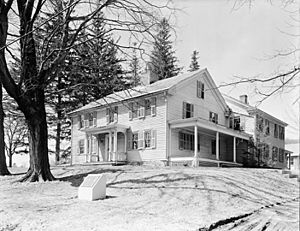
In June 1847, Melville got engaged to Elizabeth "Lizzie" Knapp Shaw. They had known each other for about three months. Melville had asked her father, Lemuel Shaw, for her hand in March. But he was first turned down. Shaw was a close friend of Melville's father. He had also helped Melville's family financially after his father died. Melville dedicated his first book, Typee, to him.
Melville and Lizzie married on August 4, 1847. They had a private wedding at home. They went to Montreal, Canada, for their honeymoon. They then settled in a house in New York City. Lizzie was a religious person. She wanted to make a home with Melville. She was willing to do hard tasks and hide her worries. She wanted to protect Melville from unpleasant things.
One example of her good humor is in a letter. She wrote that it felt like she was just "here for a visit." But the feeling went away "when Herman stalks into my room without even the ceremony of knocking, bringing me perhaps a button to sew on, or some equally romantic occupation." On February 16, 1849, their first child, Malcolm, was born.
In March 1848, Mardi was published. Nathaniel Hawthorne thought it was a rich book. He said it had "depths here and there that compel a man to swim for his life." The book started as another South Sea story. But Melville changed it. It became an adventure story and then an allegorical journey.
In October 1849, Redburn was published. This book showed Melville's own youthful struggles. It was a mix of different popular story types. These included adventure, travel, and gothic thrillers. His next novel, White-Jacket, was published in January 1850.
Hawthorne and Moby-Dick (1850–1851)
Melville first mentioned Moby-Dick in a letter on May 1, 1850. He told a fellow writer, Richard Henry Dana Jr., "I am half way in the work." In June, he described the book as "a romance of adventure." He said it was based on "wild legends" of whaling. He promised it would be done by the fall.
That summer, Melville read books by Thomas Carlyle. These readings were important. Melville changed his plan for the novel. He created what one writer called "the most ambitious book ever conceived by an American writer."
From August 4 to 12, 1850, Melville and other writers gathered in Pittsfield. Nathaniel Hawthorne joined the group. On a picnic, Hawthorne and Melville talked deeply. Melville had read Hawthorne's short stories. He wrote a review called "Hawthorne and His Mosses." It was published in August. Melville wrote that Hawthorne's stories showed a dark side. He compared Hawthorne to Shakespeare. He said great writers were being born in America.
In September 1850, Melville borrowed money from his father-in-law. He bought a 160-acre farm in Pittsfield, Massachusetts. Melville named his new home Arrowhead. This was because arrowheads were found there during planting season. That winter, Melville visited Hawthorne. Hawthorne was busy working. Hawthorne's wife gave Melville some of her husband's books. Melville invited them to visit Arrowhead. He hoped to talk about the universe with Hawthorne.
Melville was very impressed by Hawthorne's mind and art. Their friendship was important to Melville. Hawthorne offered him the "intellectual stimulation he needed." In his essay on Hawthorne, Melville wrote that Hawthorne had put "germinous seeds into my soul." Melville dedicated Moby-Dick to Hawthorne. He wrote: "In token of my admiration for his genius, this book is inscribed to Nathaniel Hawthorne."
On October 18, 1851, The Whale was published in Britain. On November 14, Moby-Dick came out in the United States. On October 22, 1851, Melville's second child, Stanwix, was born. In December, Hawthorne told a friend, "What a book Melville has written!" He saw how unique and powerful Melville's new novel was.
Struggles as a Writer (1852–1857)
Melville had hoped his next book would be popular. He wanted it to help his finances. In April 1851, he told his British publisher his new book had "unquestionable novelty." But Pierre: or, The Ambiguities was a very psychological book. It was hard to read and was not well received. One newspaper even published an attack titled "HERMAN MELVILLE CRAZY."
On May 22, 1853, Melville's third child, Elizabeth (Bessie), was born. Around that time, Herman finished a story called Isle of the Cross. He tried to get it published, but it was lost.
After Pierre failed, Melville had trouble finding a publisher for his next novel, Israel Potter. This story about a Revolutionary War veteran was published in parts in Putnam's Monthly Magazine in 1853. From November 1853 to 1856, Melville published fourteen short stories and sketches. These appeared in Putnam's and Harper's magazines. In December 1855, he suggested publishing a collection of his short stories. The collection was called The Piazza Tales. It included a new story, "The Piazza," and five others. These included "Bartleby, the Scrivener" and "Benito Cereno". On March 2, 1855, the Melvilles' fourth child, Frances (Fanny), was born. His book Israel Potter was also published during this time.
Writing The Confidence-Man was very stressful for Melville. His father-in-law was worried about him. He described Melville's work habits. He said Melville would study for many hours a day. He had "little or no exercise." This would bring on "severe nervous affections." His father-in-law gave Melville money for a trip. He wanted him to travel in Europe and the Holy Land.
From October 1856 to May 1857, Melville went on a six-month trip. He visited Europe and the Mediterranean. In England, he met Hawthorne again. Hawthorne was working as a United States Consul in Liverpool. They talked about deep topics. Hawthorne wrote in his journal that Melville had "a very high and noble nature."
The trip to the Mediterranean included the Holy Land. This inspired his long poem Clarel. On April 1, 1857, Melville published his last full-length novel, The Confidence-Man. This novel is now praised for exploring ideas of honesty and identity. But when it was published, it received confusing or negative reviews.
Life as a Poet (1857–1876)
To earn money, Melville started giving public lectures. He lectured from late 1857 to 1860. He gave three lecture tours. He spoke mostly about Roman statues and sightseeing in Rome. His lectures were not popular. People thought he made fun of the intellectual culture of the time.
On May 30, 1860, Melville sailed on the ship Meteor to California. His brother Thomas was the captain. After a difficult trip, Melville returned to New York alone in November. Later that year, he sent a poetry collection to a publisher. But it was not accepted and is now lost. In 1863, he bought his brother's house in New York City and moved there.
In 1864, Melville visited the battlefields of the American Civil War. After the war, he published Battle Pieces and Aspects of the War (1866). This was a collection of 72 poems about the conflict. The book did not sell well. Reviewers did not understand that Melville had chosen a simple, direct style.
In 1866, Melville became a customs inspector in New York City. He worked there for 19 years. He was known for being honest in a job that was often corrupt. During these years, Melville suffered from stress and pain. In 1867, Malcolm, his older son, died at 18. In May 1867, Lizzie's brother tried to get her to leave Melville. He feared Melville was losing his mind. But Lizzie refused, perhaps because she still loved her husband.
Even though his professional writing career had ended, Melville kept writing. He spent years on his long poem Clarel: A Poem and a Pilgrimage (1876). This 18,000-line epic poem was inspired by his 1856 trip to the Holy Land. It is one of the longest poems in American literature. The main character, Clarel, is a young American student. He travels to Jerusalem to renew his faith. One character, Rolfe, is like a younger Melville. Another, Vine, is based on Hawthorne. The publication of 350 copies was paid for by money from his uncle. But the book sold very poorly. The unsold copies were burned.
His Final Years (1877–1891)
Melville's own income was still low. But in 1884, Lizzie received money from an inheritance. This allowed him to buy books and prints every month. Melville retired on December 31, 1885. Other relatives of his wife also left them money. On February 22, 1886, Stanwix, their younger son, died at age 36. He died in San Francisco from tuberculosis. In 1889, Melville joined the New York Society Library.
Melville became a little more popular in England. Readers there rediscovered his novels. He published two collections of poems. These were inspired by his early experiences at sea. They were meant for his family and friends. Only 25 copies of each were printed. The first was John Marr and Other Sailors (1888). The second was Timoleon (1891).
He died on the morning of September 28, 1891. His death certificate said he died from "cardiac dilation" (a heart condition). He was buried in Woodlawn Cemetery in the Bronx, New York City. There were only a few obituaries (death notices).
The New York Times first death notice misspelled his masterpiece as "Mobie Dick". This misspelling was later wrongly used to say he was not appreciated. But some newspapers did appreciate him. The Times published a longer article on October 2. The author wondered why his books were no longer read.
Melville left a book of poetry, Weeds and Wildings, and a sketch, "Daniel Orme," unpublished. His wife also found pages for an unfinished short novel. It was called Billy Budd. Melville had changed the manuscript many times. The pages were messy. Lizzie could not understand his intentions or his handwriting. She gave up trying to publish it. The pages were kept in a family breadbox until 1919. Then Melville's granddaughter gave them to Raymond Weaver. Weaver published a quick version in 1924. This version had many mistakes. But it was an immediate success in England and the United States. In 1962, scholars published a better version. Billy Budd was made into a play in 1951. Then it became an opera and a film in 1961.
How Herman Melville Wrote
His General Storytelling Style
Melville's writing style changed a lot over the years. His early works, like "Fragments from a Writing Desk," showed his love for using many literary references. Typee and Omoo were adventure stories. They were divided into short chapters. This made them easy to read.
Some chapters of Moby-Dick are very short. One chapter has only 36 words. Melville was very skilled at using chapters in Moby-Dick. This shows his masterful writing style. Later, in Pierre, his chapters were called Books. They were divided into short numbered sections. This was a strange mix of his usual style and a more formal romance style.
After Mardi, Melville's writing seemed to go back to his first two books. But it was not a step backward. His writing became "denser in substance" and "richer in feeling." The language in Omoo was simple. But Redburn showed better storytelling. It blended images and emotions.
Melville's early works had a very detailed style. In Moby-Dick, his vocabulary grew huge. One critic called it an "immensely varied style." He often repeated words for emphasis. He also used unusual adjective-noun pairs. For example, "concentrating brow." He also used words to emphasize what was coming.
After Pierre, Melville's writing became less experimental. His words were chosen to make clear impressions. The language showed a "controlling intelligence." It reflected "right judgment and completed understanding." Compared to the energy of Moby-Dick, his later works seemed quieter.
Melville's paragraphs in his best work were compact. They also added new information freely. For example, the mysterious sperm whale is compared to God in Moby-Dick. Over time, his paragraphs became shorter. His sentences became longer. In The Confidence-Man, many paragraphs are just one long sentence. This technique helped make Billy Budd very concise.
His Style and Literary References
Melville's sentences often had a loose structure. This made it easy to use lists and references. He used parallel phrases and proverbs. His writing was influenced by the King James Bible. He also used Shakespeare and Milton. He rarely quoted directly from these sources. Instead, he changed their language to fit his stories.
Biblical elements in Melville's style appear in three ways. First, he used references within the story. Certain Biblical phrases appeared often. Examples include "death on a pale horse" and "the wages of sin is death." Second, he rephrased Bible verses. For example, Redburn's line "Thou shalt not lay stripes upon these Roman citizens" uses language from the Ten Commandments. Third, he used Hebrew ways of speaking. For example, "I dreamed a dream."
In 1849, Melville got a copy of Shakespeare's works. The large print was good for his tired eyes. He studied Shakespeare deeply. This greatly influenced Moby-Dick (1851). One critic said Shakespeare's language helped Melville find his full strength. Debts to Shakespeare can be found on almost every page. Reading Shakespeare helped Melville express powerful ideas.
Melville used three main techniques from Shakespeare. First, he used action verbs. This created a sense of movement. Second, he used strong word combinations. For example, "full-freighted." Third, he used one part of speech as another. For example, using 'earthquake' as an adjective.
Melville's style also connected to his themes. His references made characters and themes seem larger than life. They suggested that another world exists beyond what we see. This other world influences our world. It holds the ultimate truth. Also, his use of ancient references gave his stories a timeless feeling.
Main Ideas in His Books
Melville's books often explored how people communicate. They also looked at the search for absolute truth. Even in his early sketch "Fragments from a Writing Desk," he showed this. He wrote about the difficulty of finding common ground for communication. This idea appeared again in "Bartleby" and "Benito Cereno."
His characters are often searching for "the absolute." This means they are looking for ultimate truth. This search is central to all of Melville's work. His stories describe this search. His themes show the changing relationship between truth and illusion. Melville struggled with questions about knowledge and God. He thought about God's existence and nature. He also considered the universe's indifference and the problem of evil.
His Legacy and Honors
In 1982, the Library of America (LOA) began publishing books. To honor Melville's importance, their first volume included Typee, Omoo, and Mardi. Later volumes also featured his work. His complete poetry was published in 2019.
On August 1, 1984, the United States Postal Service released a stamp. It was a 20-cent stamp to honor Melville. The first day of issue event was held at the Whaling Museum in New Bedford, Massachusetts.
In 1985, a society gathered in New York City. They named the intersection of Park Avenue South and 26th Street as Herman Melville Square. This is where Melville lived from 1863 to 1891. He wrote Billy Budd there. Melville's house in Lansingburgh, New York, is now home to the Lansingburgh Historical Society.
In 2010, a new species of extinct giant sperm whale was named. It was called Livyatan melvillei. This was done to honor Melville. The scientists who found the fossil were fans of Moby-Dick. They dedicated their discovery to the author.
Images for kids
See also
 In Spanish: Herman Melville para niños
In Spanish: Herman Melville para niños


